Hisense proves here that it can deliver products of really decent quality. The Hisense U7NQ is a television that offers many advantages, with its picture quality being one of its main assets. Thanks to Mini LED technology, this television offers deep blacks and high brightness, positively influencing contrast and image dynamics. Dolby Vision support further increases the capabilities of this model, providing cinematic experiences at home. When it comes to motion smoothness, the Hisense U7NQ is a great choice for gamers and those who appreciate dynamic content, such as sports. The rapid 144 Hz panel, low input lag, and additional features like VRR, ALLM, and Game Bar make gameplay on this television smooth and responsive. For daily usage, the television deserves praise for its high efficiency during the day. The high brightness level of 915 cd/m² means that the television performs well even in bright rooms, and additional features like the ability to record programs make it a very functional everyday choice. Despite all its advantages, the Hisense U7NQ also has its drawbacks. The VIDAA operating system, while fast, is not yet as developed as other platforms available on the market, resulting in the absence of several popular applications such as Spotify or Tidal. Gamers may be disappointed by the lack of support for HGiG, which affects the optimal reproduction of details in HDR games. If we plan to connect the television to a computer, we must reckon with issues related to font readability, especially on dark backgrounds. The Hisense U7NQ is a solid TV that offers very good picture quality and rich features for gamers. Despite a few shortcomings, it is a model that will satisfy most users, providing high picture quality, motion smoothness, and useful user features.
- Matching (Score)
- Our verdict
- TV appearance
- Where to buy
- Contrast and black detail
- HDR effect quality
- Factory color reproduction
- Color reproduction after calibration
- Smoothness of tonal transitions
- Image scaling and smoothness of tonal transitions
- Blur and motion smoothness
- Console compatibility and gaming features
- Input lag
- Compatibility with PC
- Viewing angles
- TV efficiency during daytime
- Details about the matrix
- TV features
- Apps
- Playing files from USB
- Sound
Hisense U7NQ vs TCL C7K / QM7K
Direct compare
Check the best price offer:
Hisense U7NQU7NQ
C7K / Q7C / MQLED85K / C79K / C71K / QM7K

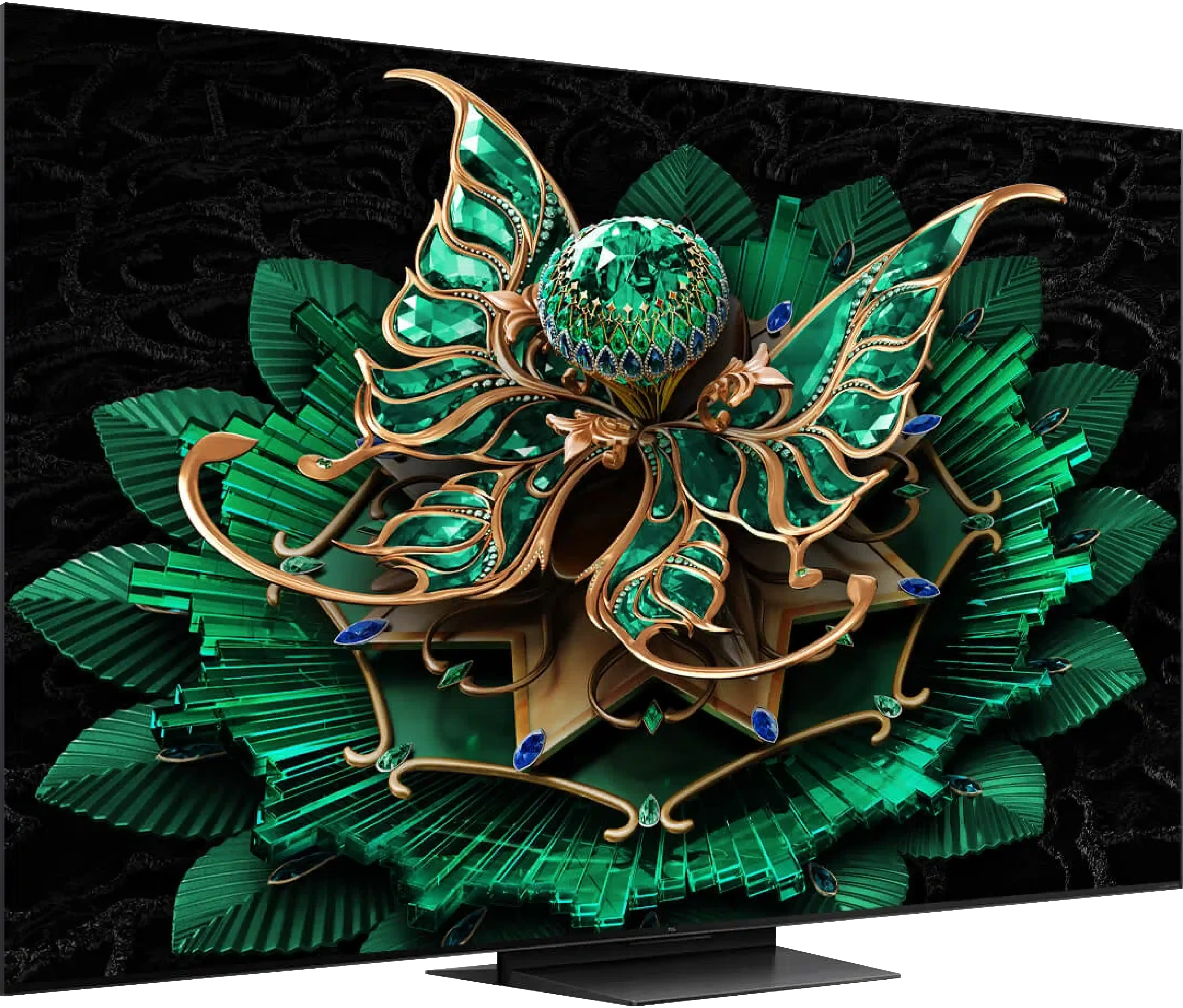
Panel type: LCD VA
Resolution: 3840x2160
System: VIDAA
Model year: 2024
Complete the survey to find out the result

Panel type: LCD VA
Resolution: 3840x2160
System: Google TV
Model year: 2025
Complete the survey to find out the result

Overall rating
7.3
7.1
Movies and series in UHD quality
7.0
6.7
Classic TV, YouTube
6.7
6.5
Sports broadcasts (TV and apps)
6.4
6.4
Gaming on console
8.2
8.5
TV as a computer monitor
8.0
8.4
Watching in bright light
7.6
6.1
Utility functions
9.0
7.7
Apps
7.7
9.6
Sound quality
6.9
7.0
Complete the survey to find out what fits your preferences
Advantages
Good contrast
High brightness of the panel - good performance during the day
Very good for gamers, sports - VRR, ALLM 144Hz
Low input lag
Recording function from built-in tuners
Very good black - VA panel with a large number of Mini-LED zones
High brightness in HDR - over 1000 nits
Great for gamers - HDMI 2.1, low input lag, VRR, ALLM, etc.
Good motion fluidity - 144Hz panel
Support for multiple HDR formats: HDR10, HDR10+, Dolby Vision
Google TV operating system with access to a huge app base
Pleasant sound from built-in speakers
Disadvantages
Not the best Image scaling and smoothness of tonal transitions
Google TV can work with minor lags
No USB recording and PiP features
Our verdict
There are TVs that come in for testing and you immediately think: "oh, another average one, probably like many others." And in fact… that's true. The TCL C7K doesn't try to dethrone the OLEDs, it doesn't shout from the box "revolution!". And yet, after a few days of testing, it's hard not to think: "wow, this is really good equipment." And that's exactly what the C7K is. The biggest asset of the C7K is its decent picture at a reasonable price – MiniLED and quantum dots do their job here. The colors are vibrant, the brightness is satisfactory, the contrast is impressive, and with the right settings, you can truly enjoy viewing in the best quality. The second strong point is the fluidity of motion – both in sports and in games. Support for HDMI 2.1, variable refresh rate, 144 Hz, and a whole bunch of other features make playing on this TV a pure pleasure. Additionally, there's Google TV, which – despite minor shortcomings – provides access to nearly an endless library of applications. Voice control, quick access to YouTube, Netflix, AirPlay support – everything you need for daily use is here. Are there any downsides? Sure. The Google TV system sometimes experiences moments of "hesitation," and MiniLED – like any MiniLED – can stumble on very challenging movie scenes. But those are details. After all, the C7K is a mid-range model – and in this class, it simply performs excellently. So if you are looking for a reasonably priced, modern TV with Google TV that looks good, works well, and sounds pretty decent without breaking your budget – the TCL C7K definitely deserves attention.
TV appearance





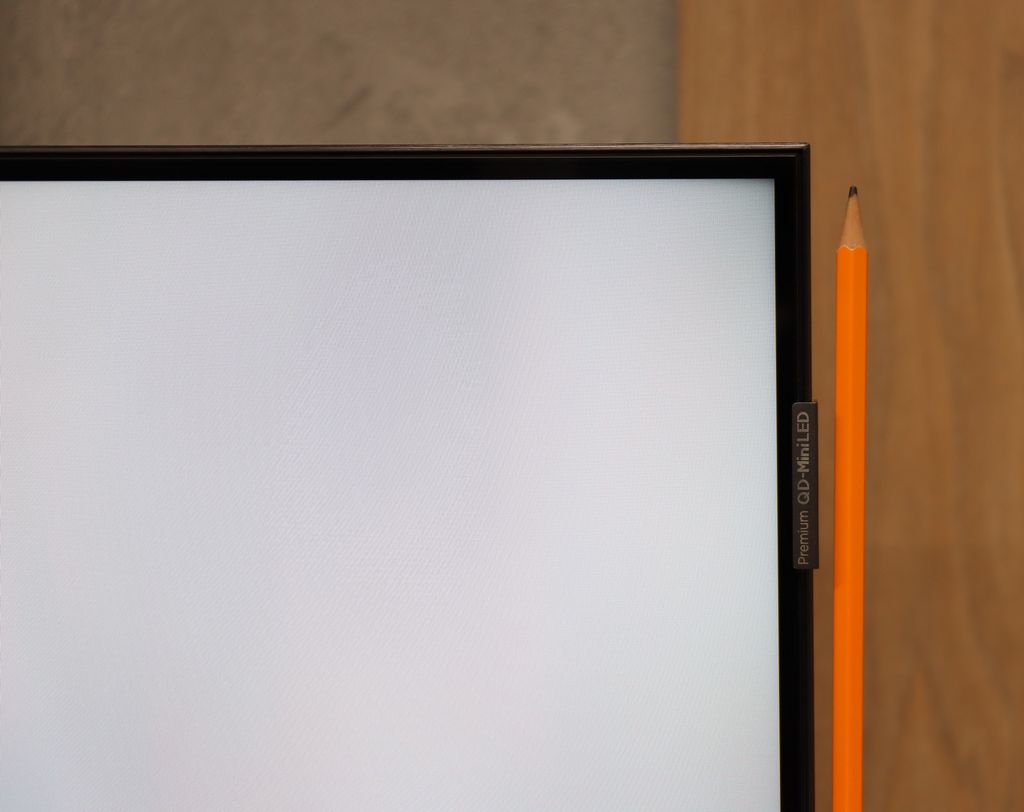
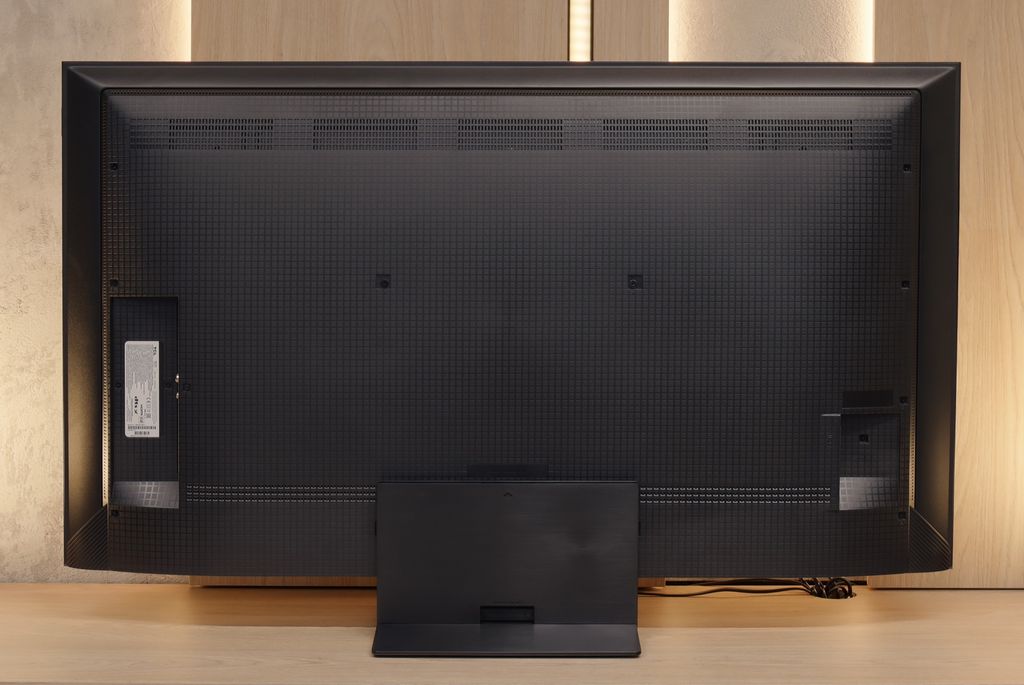
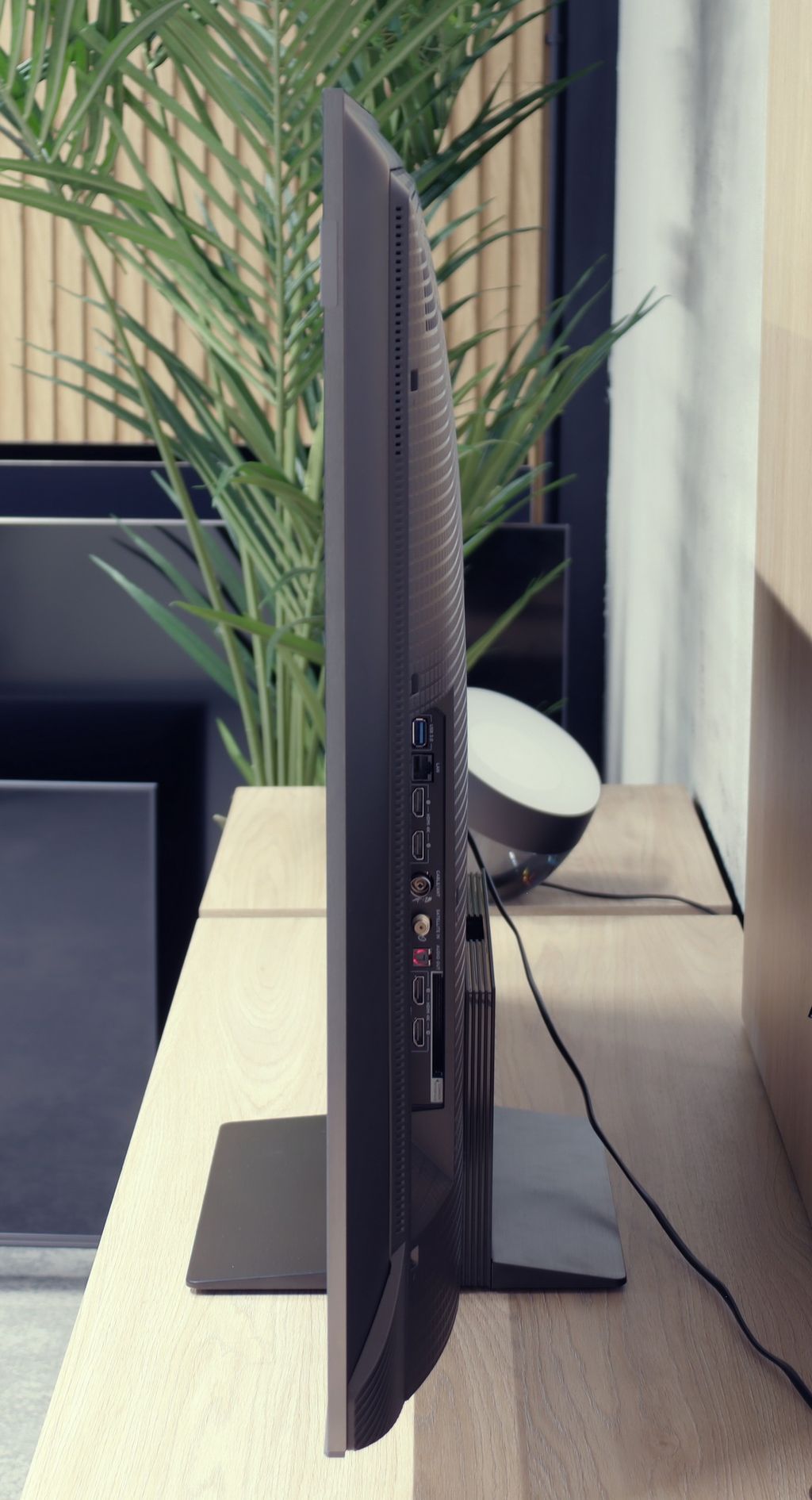
Contrast and black detail
7.2/10
7.1/10
Local dimming function: Yes, number of zones: 713 (31 x 23)
Local dimming function: Yes, number of zones: 336 (14 x 24)
Contrast:

Result
40,750:1

Result
42,600:1

Result
12,000:1

Result
12,150:1

Result
3,450:1

Result
161,000:1

Result
18,750:1

Result
13,150:1

Result
6,300:1

Result
4,200:1
Halo effect and black detail visibility:

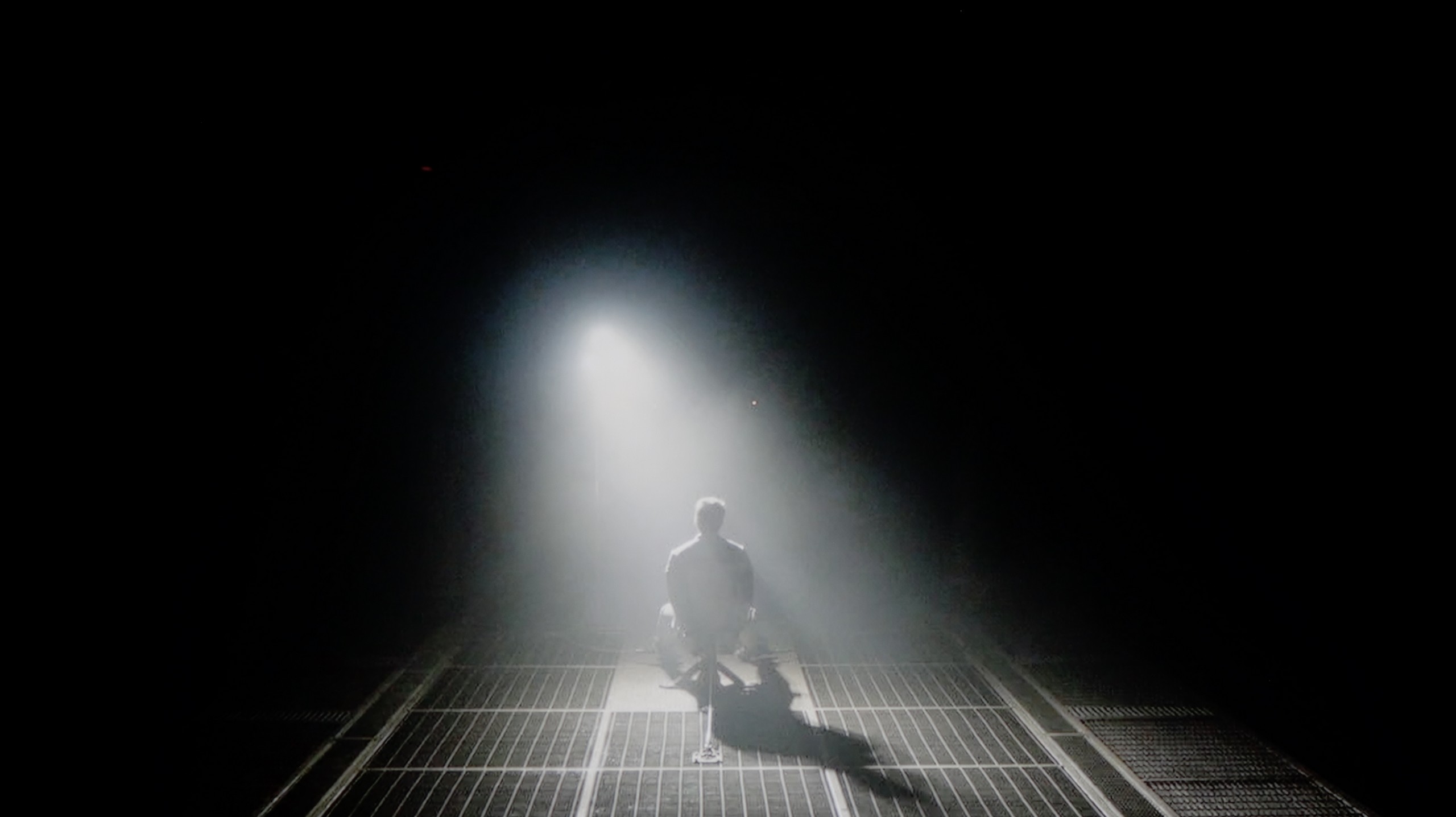
Hisense U7NQ is a television that uses a VA panel, crucial for achieving good contrast and appropriate black depth. This technology translates into vivid image quality when watching content in a dark room, where blacks acquire proper saturation and resemble deep tar rather than washed-out ash. Moreover, the TV features Mini LED backlighting, which in the tested 65-inch variant offers an impressive number of 713 local dimming zones. Naturally, smaller sizes will have fewer zones, while larger ones will have more, positively affecting overall contrast.
Under very favourable conditions, the TV achieves a contrast ratio of around 40,000:1. The local dimming technology performs excellently at managing bright and dark parts of the image, making the TV superbly render details in complex scenes. Despite the large number of zones, there may be issues with contrast in particularly demanding scenes, where small bright elements appear against a dark background. Sometimes the TV may dim these elements too much, causing a loss of brightness, and other times it excessively brightens them, leading to a halo effect—glows of light surrounding objects. This effect can be noticeable, for example, in a scene from the movie Sicario 2, where bright glows around the subtitles can be bothersome.
Nevertheless, the use of Mini LED technology with local dimming makes the overall image quality significantly better than in televisions without this technology. The effect is particularly noticeable when watching movies in a dark room—the blacks are deeper, and the contrast is more pronounced, allowing a full appreciation of details hidden in dark shots.
The 50-inch TCL C7K that we tested surprised us right from the start – it's the smallest model in the series, yet it comes equipped with a VA panel with MiniLED backlighting and – attention – as many as 336 dimming zones. For comparison: many significantly larger TVs from higher tiers would be eager to boast such a number. Here we have it in the 50-inch version. Sounds promising, right? So how does this translate into real movie-watching experiences? In the vast majority of tested scenes – very well. The contrast was so high that in measurements it even reached six-digit values, which in practice means very deep blacks and well-separated highlights. In scenes from movies like The Revenant or Oblivion, the effect was impressive, matching the best LCD screens in this class.
However, not everything went perfectly. Despite the impressive number of zones, their management was not always exemplary. In more complex scenes, where there are small light sources or a high level of detail, the TV had issues with the so-called halo effect (a glowing halo around bright objects) or with overly aggressive dimming of the image. In such situations, contrast could either collapse due to overexposing parts of the zones or, conversely – details in bright areas disappeared because the zones suppressed the light too much. Nevertheless, it's worth emphasizing that in the vast majority of scenes, the contrast was more than satisfactory. And considering the size of the TV and its price, the final effect will satisfy not just average users.
HDR effect quality
5.9/10
5.4/10
Luminance measurements in HDR:

Result
1023 nit

Result
290 nit

Result
637 nit

Result
198 nit

Result
907 nit

Result
1051 nit

Result
185 nit

Result
454 nit

Result
200 nit

Result
836 nit
Scene from the movie “Pan” (about 2800 nits)

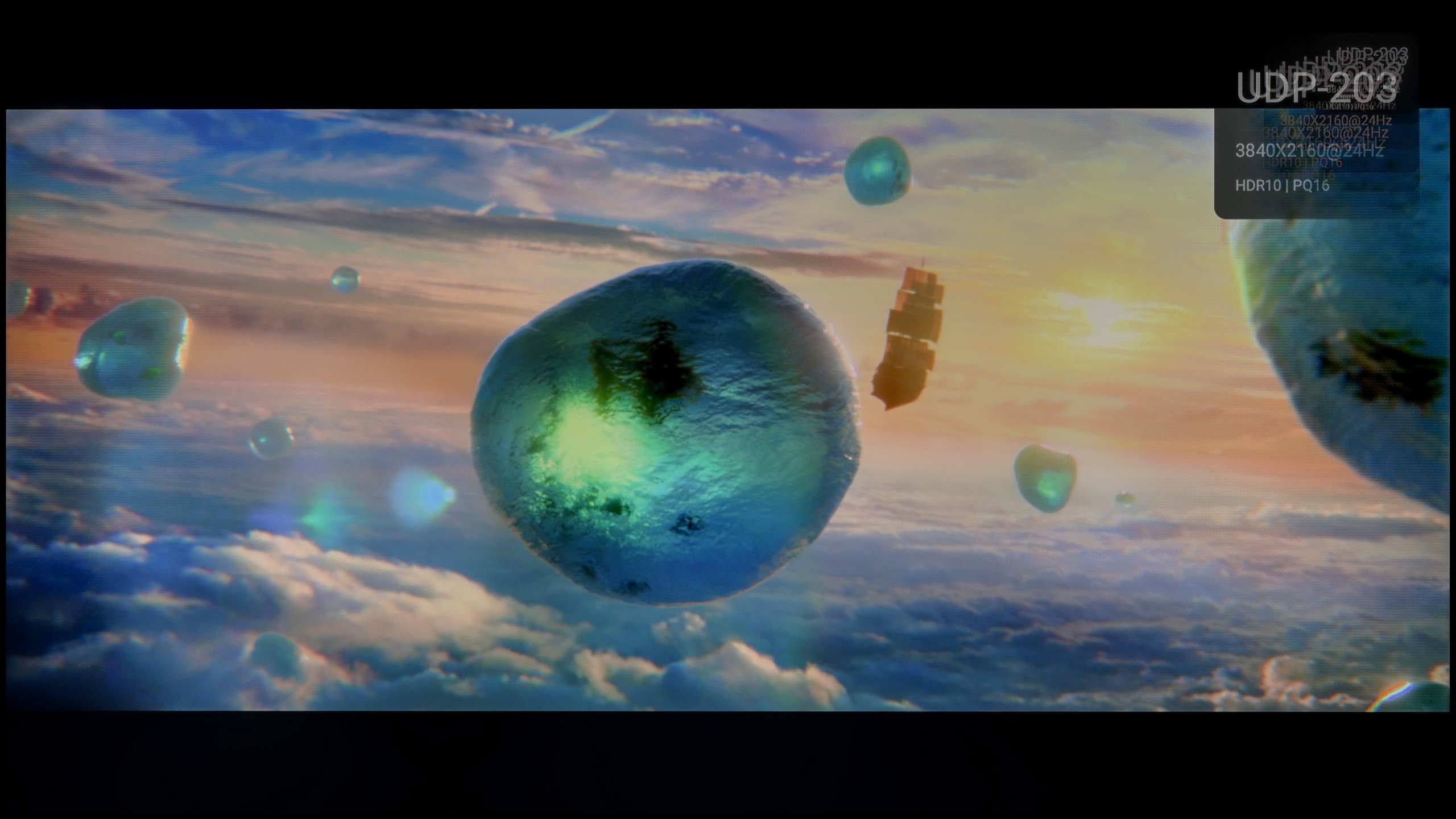
Scene from the movie “Billy Lynn” (about 1100 nits)


Static HDR10


Dynamic: Dolby Vision
Dynamic: Dolby Vision


HDR luminance chart:
TCL C7K / QM7K
Luminancja HDR
Luminance of RGB colors
Hisense U7NQ
Luminancja HDR
Luminance of RGB colors
The Hisense U7NQ 65 television demonstrated significant capabilities on the luminance chart, exceeding the 1000-nit barrier and achieving very high brightness results without issue in the first, third, and fifth test scenes. However, as before, in the second and fourth test scenes, for example from the film Sicario 2, there are significant problems with maintaining brightness, and the results around 200 nits are very disappointing. Despite a large number of dimming zones, the algorithm in the television responsible for controlling these zones is unable to react appropriately — in this case, it significantly dims small elements like the moon or the light from a helicopter. The bright light that should blind us is too dim to be called an HDR effect. Nevertheless, it is worth praising the television for its high coverage of the DCI-P3 colour gamut at 96%, which allows it to accurately reproduce most film scenes.
TCL C7K is one of the brightest MiniLED televisions in its price range. Under the best test conditions, the screen was able to achieve over 1200 nits, resulting in impressive, and at times blindingly bright scenes. And most importantly – this is not just a theoretical measurement. In practice, the brightest parts of movies can shine with true cinematic grandeur. Home HDR cinema fans should be truly pleased.
The impression is especially great in scenes with large areas of brightness – white skies, explosions, sun reflections, or magical sunsets can surprise with the intensity of light that rarely appears in this price range.
However, things get a bit worse when more challenging scenarios appear on the screen, which have been described in terms of contrast – meaning images full of details, with small bright elements against a dark background. In such cases, the C7K often chooses to retain black at the expense of brightness. An example? Scenes from the movies Sicario 2 or Life of Pi, where small light sources (like a distant lantern) can be less visible, and details in the lights are simply dimmed or blend into the background.
For many viewers, this may be an acceptable compromise – as we achieve deep blacks and pleasant image texture. Nevertheless, it is worth being aware that the visibility of small details in bright areas is not the strongest suit of this model. It is simply a technological limitation that still exists – even with over 300 zones.
Factory color reproduction
6.4/10
6/10


Factory Mode
After calibration
The Chinese manufacturer offers various picture settings with its televisions, but the best mode in this model is undoubtedly the Filmmaker Mode. Despite its name, this mode has its issues: the white balance, although roughly correct, is characterized by a strong dominance of warm tones due to the kick of red colour, both in 4K and HD materials. The Colour Checker test confirms these errors — deviations in samples are visible in inappropriate shades. As for the brightness characteristics, the gamma responsible for HD materials shows values below 2.4, leading to some brightening of the screen. Meanwhile, the EOTF curve shows the television's problems with displaying small light elements, as confirmed by the previously described paragraphs.
A new feature in TCL televisions for 2025 is the long-awaited Filmmaker mode, which until now could be found in most competitive brands. This is great news because this mode is considered the truest to the original vision of the creators and is often recommended by enthusiasts of good image quality. Unfortunately – as is often the case – the mere presence of this feature does not guarantee perfection. The Filmmaker mode in the TCL C7K is not free of flaws. One could point out the incorrect white balance, particularly the slight dominance of blue, which caused cool, somewhat grayish skin tones. But that was not the biggest problem. The main complaint was excessive brightness exposure, which is clearly visible on the gamma and EOTF graphs. The image was simply too bright, at times even blown out, which affected not only the plasticity of the scenes but also the overall viewing experience. Some details simply got lost, and the whole image looked as if someone had overdone it with the brightness slider. As always – we decided to see what could be squeezed out of it after calibration. And this is where things got really interesting...
Color reproduction after calibration
7.8/10
7.5/10

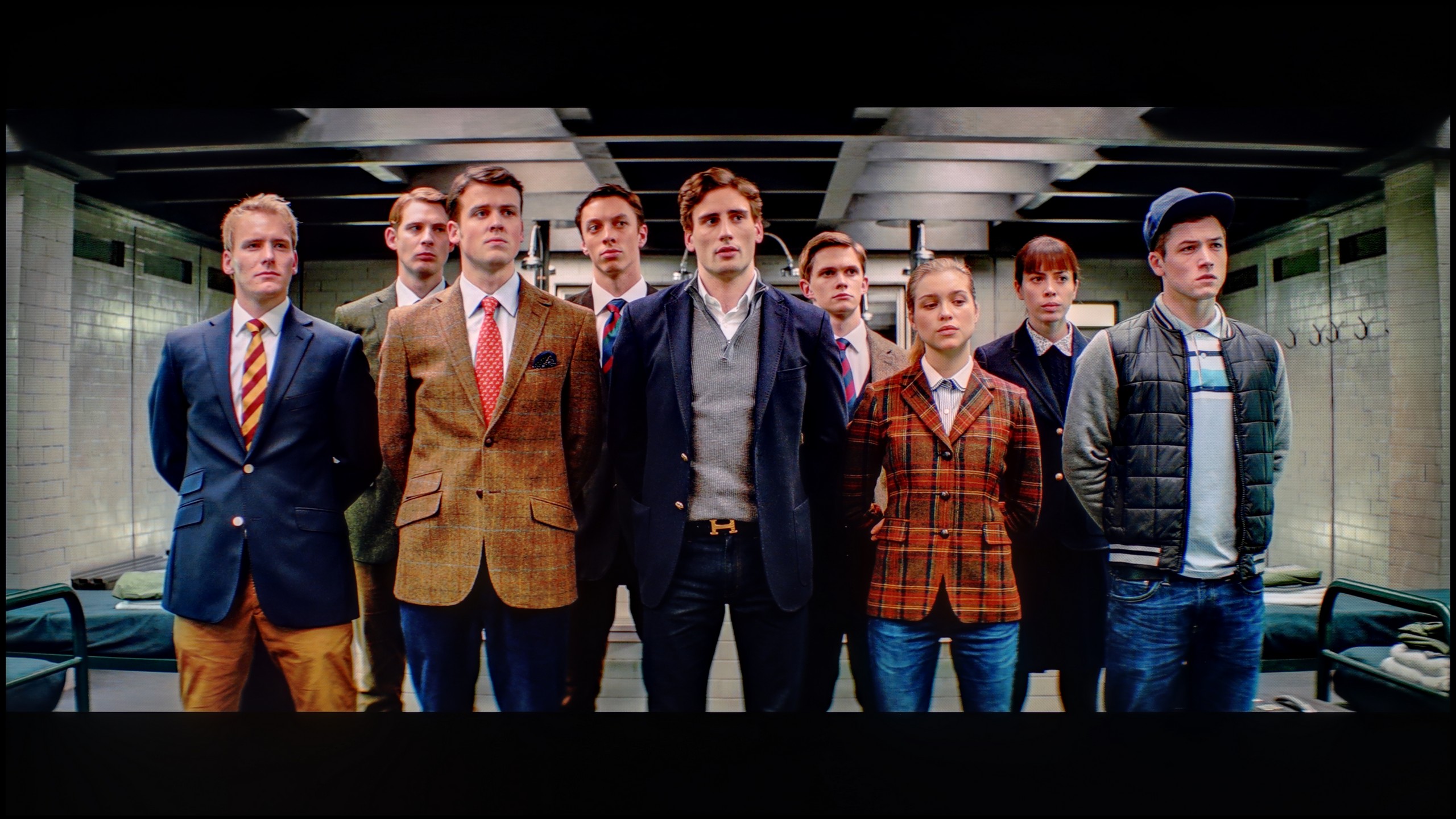


Hisense televisions offer many tools for image correction, allowing users to adjust settings to their preferences. Therefore, we decided to utilize these capabilities to bring the image quality closer to reference standards. In the case of white balance, we managed to eliminate the dominance of red, resulting in more neutral colours, which allowed for a more realistic image in both 4K and HD materials. A similar improvement was noticed in the brightness characteristics. Gamma, which previously led to excessive screen brightness, was corrected, contributing to better detail representation in the darker areas of the image while maintaining a natural tonal balance.
However, the biggest challenge was the calibration of the EOTF curve, which is responsible for brightness in 4K materials. At first glance, the EOTF value appeared almost perfect, but detailed tests showed a slightly different outcome. Upon closer inspection—especially using the filter on the right side of the EOTF chart—we noticed how the television manipulated 4K film materials, often significantly boosting brightness. This effect was particularly noticeable in scenes from films such as Pan and Billy Lynn, where the television attempted to artificially increase the brightness of elements, affecting their naturalness. Despite these imperfections, the calibration yielded positive results, especially in terms of tonal improvement. For most users, the final effect should be satisfactory, especially if they aim to bring image quality closer to professional reference standards.
After calibration, the TCL C7K showed itself in a really good light, especially when it comes to SDR content. We managed to fine-tune the white balance, color gamut, and brightness characteristics so precisely that color errors on the ColorChecker palette dropped below a value of 2. For the uninitiated – this is an almost perfect result, meaning that the image is very close to what the creators intended. Unfortunately, it was less impressive with 4K HDR content. Although we managed to slightly calm the white balance and correct its earlier errors, it is still evident that the TV has certain "MiniLED traits," especially in managing brightness. When we checked how the C7K performed with the EOTF curve on real movie scenes rather than just synthetic test patterns, it turned out that the screen still has a tendency to slightly brighten the entire image. This affects the overall experience – the black loses some depth, and the image becomes less contrasty than it should be. Despite these minor shortcomings in HDR content, the overall reception of materials – especially in SDR – is really very good. After calibration, the C7K can display an image that can successfully compete with much more expensive models. Good color tuning, natural skin tones, and pleasant brightness make movie sessions and everyday content viewing more than satisfactory.
Smoothness of tonal transitions
9.1/10
8.6/10












Hisense U7NQ offers excellent fluidity of tonal transitions. Overall, the image is very well balanced, and transitions between different shades of colors are nearly flawless. For more discerning viewers, small joinings in darker hues can be detected; however, these imperfections are minimal and do not significantly affect the overall picture quality. Tonal fluidity is at a very high level, making viewing content on this television particularly enjoyable, with no noticeable problems with gradients and color transitions.
The TCL C7K handles color gradation very well – in most tested scenes, tonal transitions were smooth, and colors blended together without visible contours or artificial “blot” effects. In everyday use, it’s hard to find fault with it – the image looks natural, without irritating transitions or digital artifacts. Some limitations only appear in very dark tones – especially in a heavily muted gray palette, where the TV may struggle to reproduce ideal gradation. But this is absolutely understandable, because even many significantly more expensive models in this range simply give up. Fortunately, these situations are rare and do not significantly affect the overall perception.
Image scaling and smoothness of tonal transitions
5.5/10
5.5/10
Smooth transition function


Image without overscan on the SD signal


When it comes to smoothing tonal transitions, despite the presence of the "Smooth and Gradient Image" feature in the test sequence, we did not notice that the feature added anything — we recommend turning it off. As for upscaling, the television handled our model well, and the branches in the background are not excessively jagged — the image seems quite plastic. However, it was slightly cropped by the so-called overscan.
The TCL C7K features a function that, according to the manufacturer, is supposed to smooth out unwanted color transitions – something like a rescue for less successful tonal shifts. It's called "Gradual Smoothing" and... well, it sounds ambitious, but in practice, it works very poorly. Regardless of whether we set it to low or high, the difference is minimal. What's worse – the function can remove elements from the image that should remain. Fortunately, film grain remains untouched, so at least it doesn't smooth everything indiscriminately, but still – it's better to just turn this option off.
As for scaling lower-resolution content, it's already better. SD and HD materials look quite decent, though sometimes we had the impression that the image loses sharpness and becomes too soft – as if something took away its clarity. Fortunately, at very low sources (e.g., 576p), there was no overscan effect, meaning the image was not artificially cropped – everything fit on the screen as it should.
Blur and motion smoothness
7.3/10
7.5/10

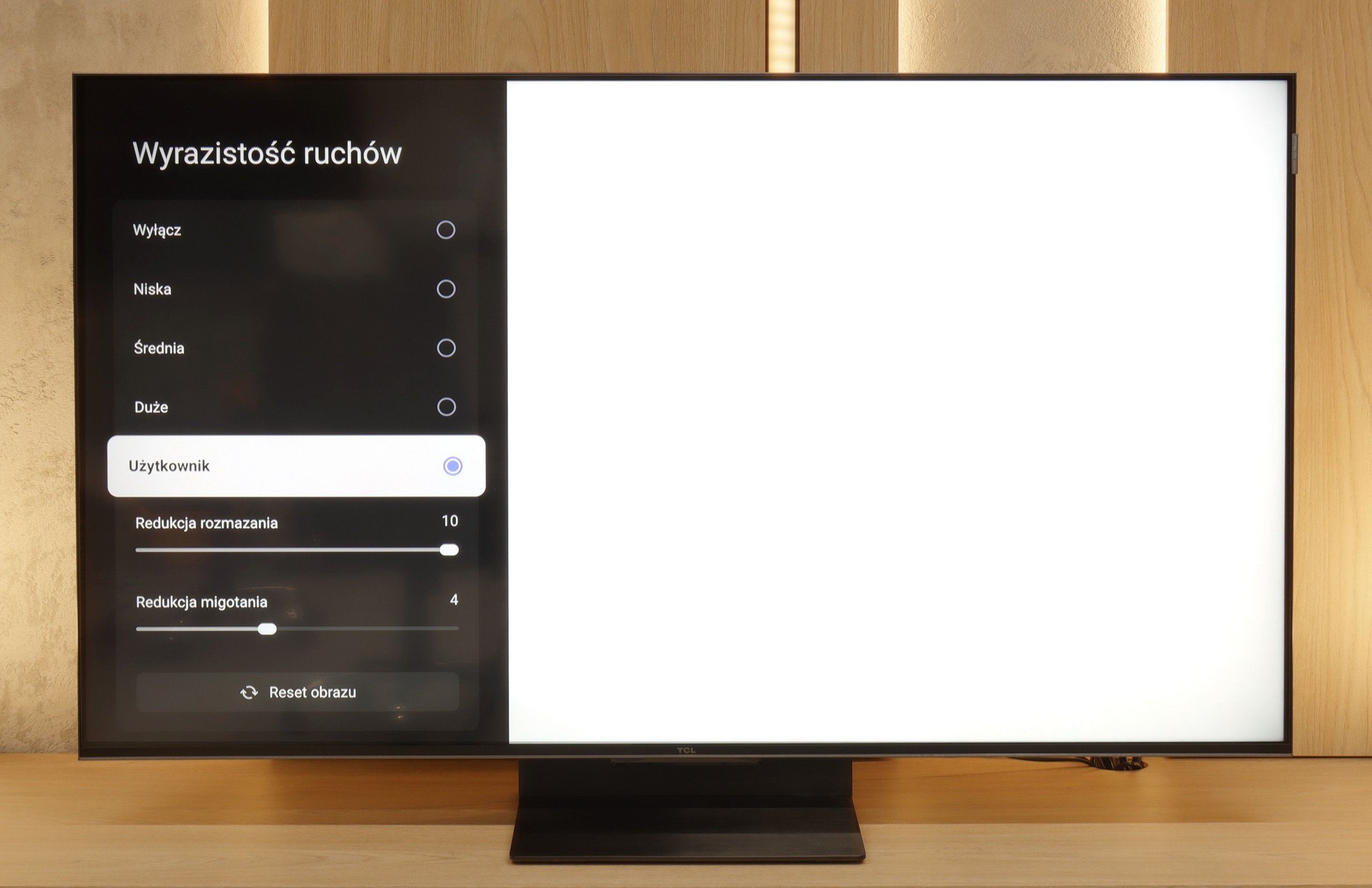
Blur (native resolution, maximum refresh rate):





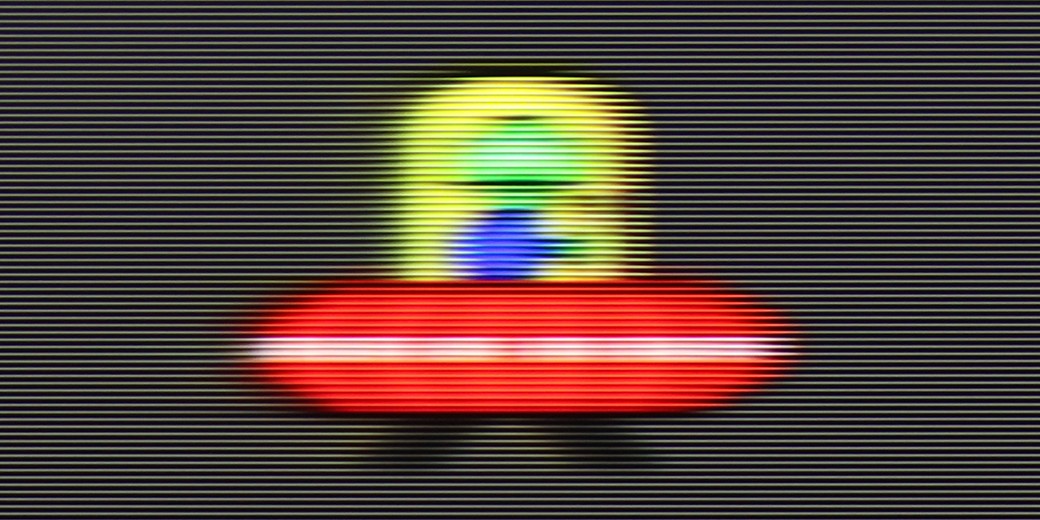
Blur (BFI function enabled):






Smużenie ():
Smużenie (4K 144Hz):



Hisense U7NQ has a refresh rate of 144 Hz, which definitely contributes to smooth motion. For movie enthusiasts, there are two features available: judder reduction and motion blur reduction. The judder reduction feature minimizes the effect of so-called judder, which is the unpleasant stuttering of the image, particularly noticeable at lower frame rates. On the other hand, motion blur reduction helps sharpen fast-moving objects, which is useful when watching dynamic action scenes.
As for motion blur, the TV has a decent response time, so excessive blurriness is not visible, except in specific situations, such as the test with the little green alien on a dark background. In such cases, slight artifacts may appear, but overall, the TV handles dynamic images well, providing satisfactory motion quality.
TCL C7K handles motion smoothness really very well. The matrix used in it offers a refresh rate of 144 Hz, which already suggests that this TV is something more than just an ordinary "60 Hz" panel. Moreover – if we connect the C7K to a computer and set the resolution to Full HD. But we will write more about this in the paragraph about gamers and PC cooperation. Returning to everyday use – both sports and movies look very good here. Thanks to the fast panel and well-functioning motion smoother, the C7K is perfect for watching matches, but also for movie screenings. In the menu, we will find two sliders – blur reduction and flicker reduction – which allow us to adjust the motion smoothness effect to our own preferences. At lower settings, we get a more cinematic effect, with slight frame motion. At higher settings – the image becomes more theatrical, smooth to the point of exaggeration. Everyone can set it to their liking.
Console compatibility and gaming features
8.5/10
9.8/10
- ALLM
- VRR
- VRR range48 - 144Hz48 - 144Hz
- Dolby Vision Game Mode
- Correct implementation of HGIG
- 1080p@120Hz
- 1440p@120Hz
- 4K@120Hz
- Game bar

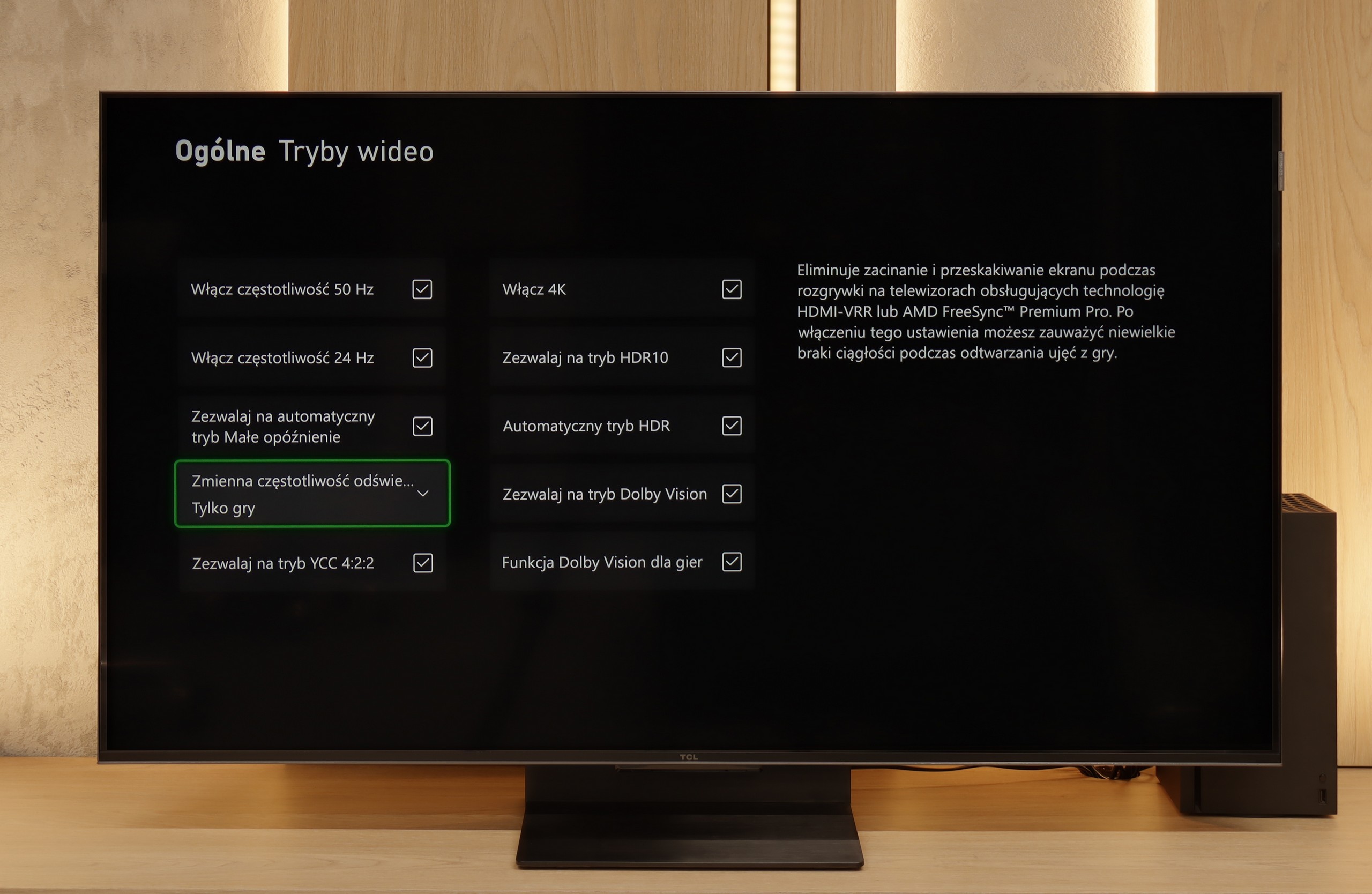

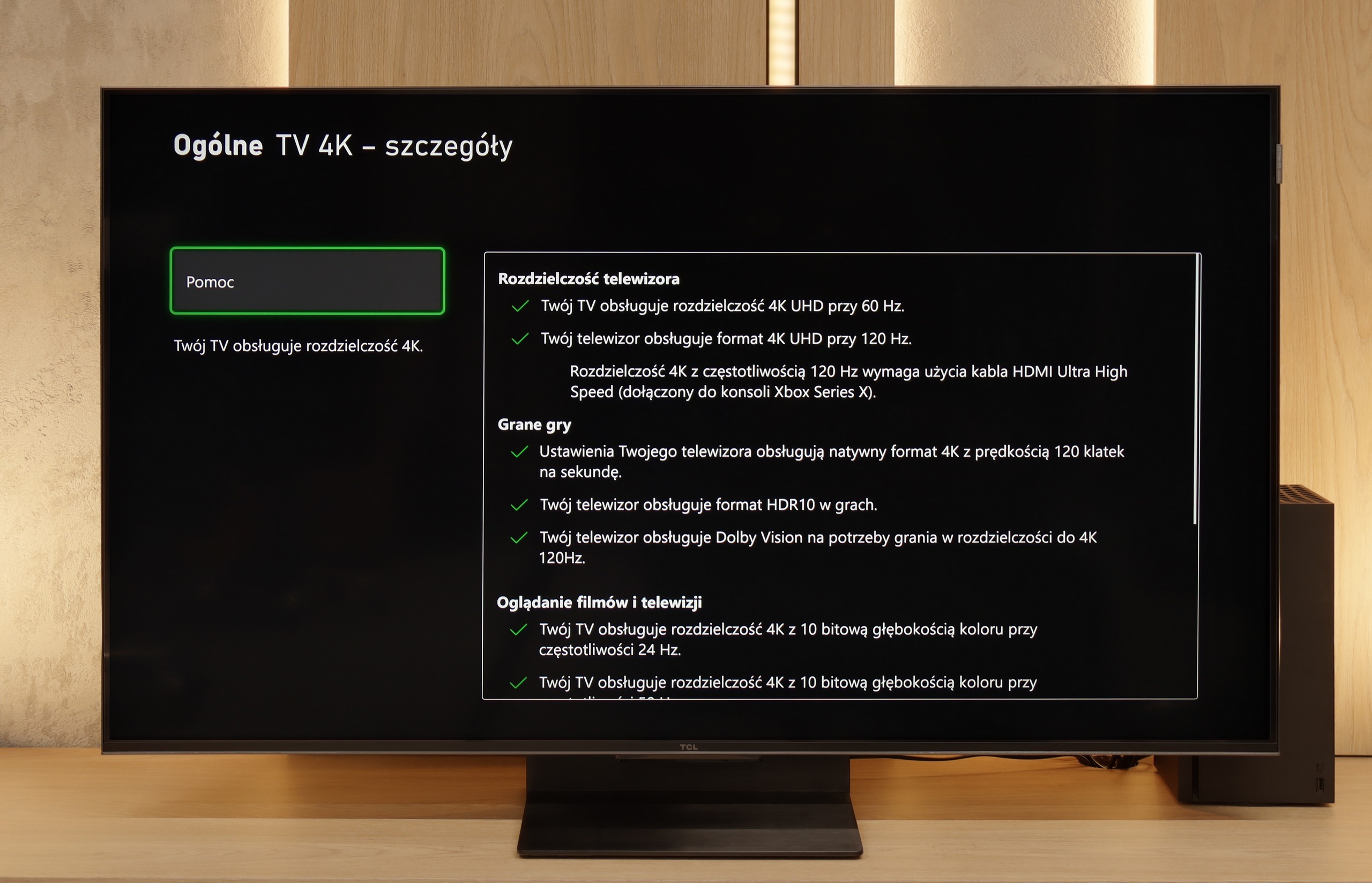

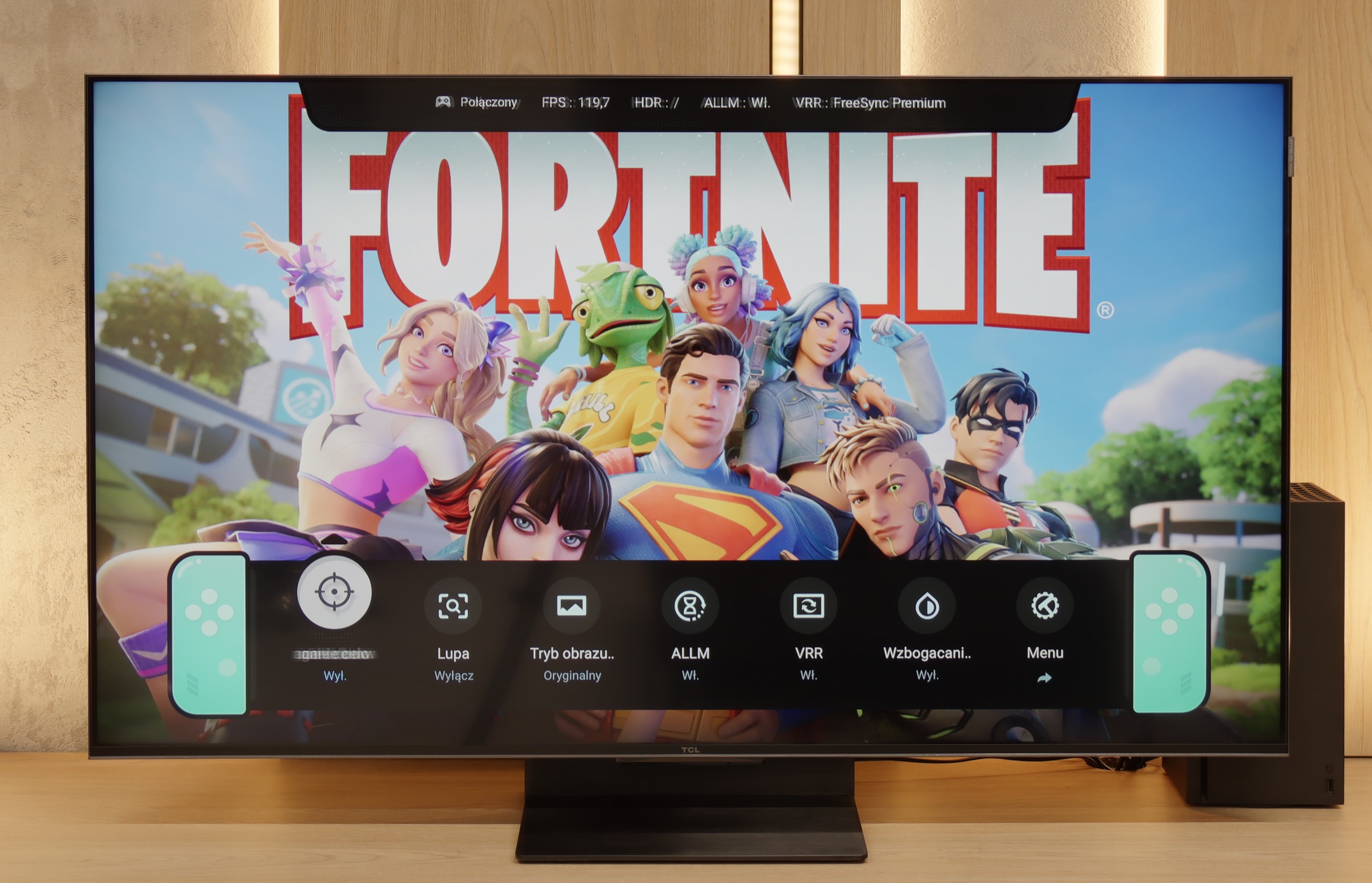

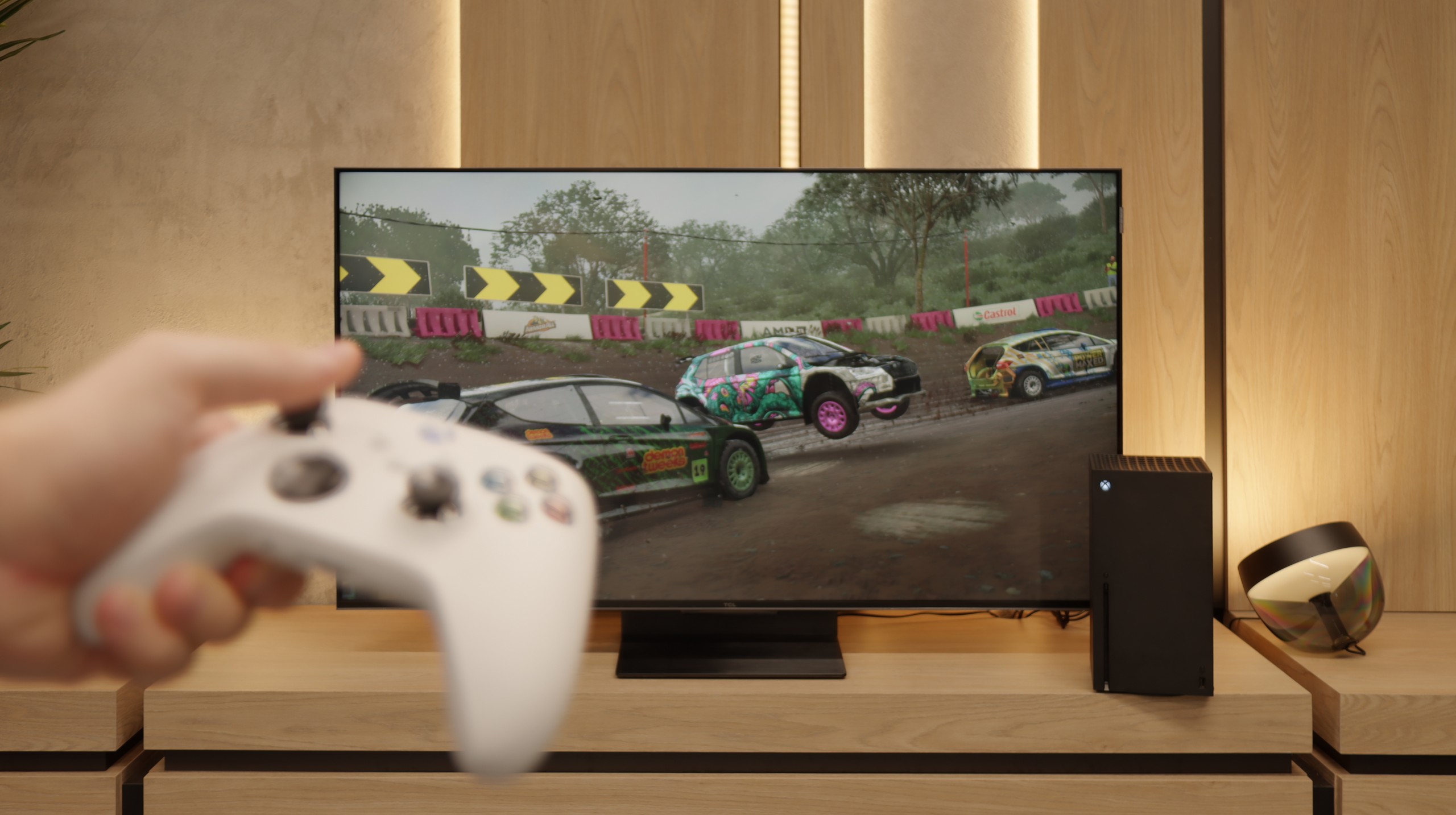
Hisense U7NQ offers everything a gamer might need for comfortable gameplay. The TV supports a refresh rate of 144 Hz, providing an incredibly smooth image, especially in dynamic action games. The VRR (Variable Refresh Rate) feature ensures that the image adapts to changing frames per second, eliminating stuttering and tearing. Additionally, there is an ALLM (Auto Low Latency Mode) feature that automatically switches the TV to game mode, minimizing input lag.
The TV also supports Dolby Vision, which is particularly important for gamers who value high contrast and vivid colors in games that support this format. The Hisense U7NQ also has a Game Bar feature that allows quick access to essential settings during gameplay, as well as support for G-Sync technology, which further reduces image tearing.
Unfortunately, despite the wide range of features, support for the most popular HDR format in gaming — HGiG — is lacking. This may be disappointing for gamers who expect optimal detail representation in HDR scenes. Nevertheless, the remaining features make the Hisense U7NQ a solid choice for any console gaming enthusiast.
TCL C7K is a TV that looks like the dream equipment for gamers on paper – and most importantly, it also performs well in practice. First, the good news: we have two HDMI 2.1 ports with full bandwidth, so we can easily connect both a console and a computer, taking full advantage of their capabilities. The panel itself supports 144 Hz refresh rate, which provides a significant advantage in dynamic games. Additionally, it comes with a full package of gaming features: VRR (Variable Refresh Rate), ALLM (Auto Low Latency Mode), and Dolby Vision support in games. There is also an HGiG mode, which allows for HDR effects that align with the creators' intentions. GameBar, which is an information bar for gamers. It operates quickly, looks clear (like a Nintendo console👌), and shows what’s most important: the current frame count, VRR status, and even HDR parameters.
Input lag
9.8/10
9.7/10
SDR
HDR
Dolby Vision
Input lag on the Hisense U7NQ is at a remarkable level, with a maximum of 16 ms, which is an excellent result even in Dolby Vision mode. This achievement is worth highlighting, as Dolby Vision mode often increases delays in other TV models, but here it has been avoided. Thanks to the low input lag, gameplay is smooth and responsive, which will be appreciated by both casual gamers and more advanced users.
When it comes to delays, the C7K doesn't give any reasons to complain. In games at 120 Hz, the input lag is around 10 ms, which means the television responds really quickly. Interestingly, even in Dolby Vision mode, the result is very similar, which is not always the standard. Good job, TCL. At 60 Hz, the lag obviously increases a bit, but that is completely normal and applies to virtually any television with a refresh rate of 120Hz and higher. The most important thing is that everything still runs smoothly and there is no feeling that something is not responding to our actions.
Compatibility with PC
8/10
8.4/10

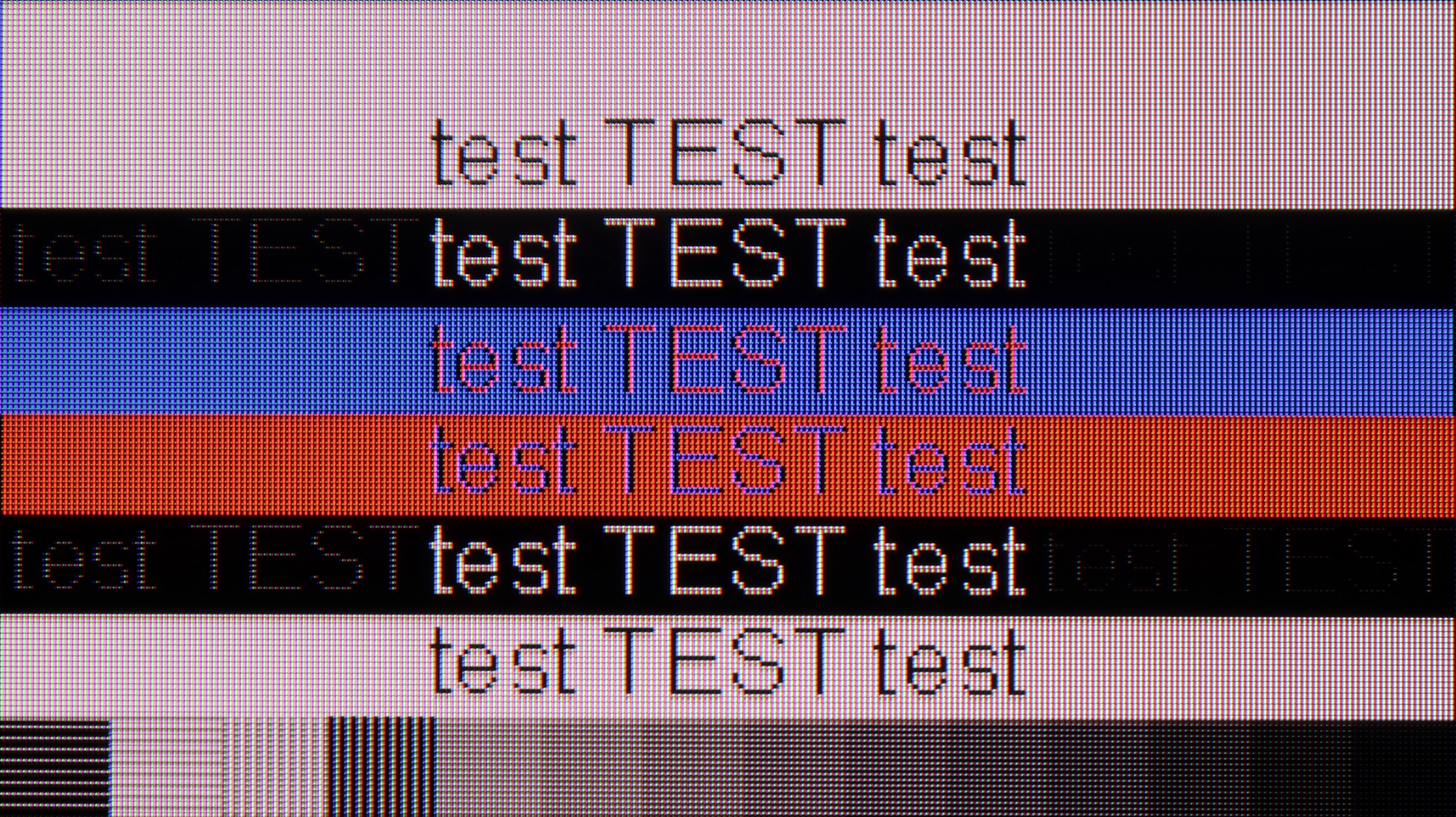
Hisense U7NQ offers full support for chroma 4:4:4, which ensures good font readability, especially when working with text. Overall, the image quality and visibility of characters are at a satisfactory level. However, it is worth noting the issue related to displaying fonts on a dark background — in this situation, the letters become practically invisible, and only vertical subpixels are visible.
If we intend to connect the C7K to a computer – especially for gaming – there’s definitely something to play with. We have 4K at 144 Hz, which sounds great on its own, but if we drop the resolution, the TV can display even 280 Hz. In e-sports, where every fraction of a second counts, this makes a real difference. On top of that, there's support for G-Sync and FreeSync, so regardless of what graphics card we have – the image will be smooth, without any stuttering or tearing.
But if we plan to put the C7K on a desk and use it like a monitor, it’s a little less “rosy.” Sure, it supports chroma 4:4:4, so fonts should be sharp, but with very dark letters, there’s a slight blurring and dimming of the edges. It’s not something that immediately stands out during gaming or watching, but when working with text – it can be distracting. In everyday use – probably without concerns, but if we plan to place a 50-inch screen a meter from our face, it’s worth keeping this in mind.
Viewing angles
3.1/10
3/10
The viewing angles on the Hisense U7NQ are typical for a VA panel. Unfortunately, they leave much to be desired. The television lacks a coating that widens the viewing angles, resulting in a significant drop in image quality when viewed at an angle. Colors become washed out, and contrast noticeably decreases, making this television best suited for viewing directly head-on. This is a limitation that needs to be considered, especially if we intend to watch television in a larger group, where viewers may be sitting at different angles.
There are no surprises here – the C7K has classic viewing angles for a VA panel. That is: sitting directly in front – it’s great. Colors look good, contrast is strong, everything is in place. But just shifting a little to the side and it starts to get worse – the image loses saturation, blacks turn gray, and the overall impression diminishes a bit. So if we plan to watch together with a few people or have a couch that takes up half the living room – it’s worth seating everyone more centrally. You can watch from the side, but don’t expect miracles – that’s just a characteristic of the VA panel.
TV efficiency during daytime
7.6/10
6.1/10




Matrix brightness
Average luminance SDR
TCL C7K / QM7K: 475 cd/m2
Hisense U7NQ: 915 cd/m2
Hisense U7NQ is equipped with a matte coating panel that moderately suppresses reflections. Nevertheless, a brightness level of 915 cd/m² is impressive and ensures that the television performs very well even in bright rooms. With such high brightness, watching content during the day is not a problem, and the image remains clear and legible even with a large amount of external light.
Fortunately, the TCL C7K performs quite well in a bright room. The applied matrix has a satin finish that effectively reduces reflections, so even on a sunny day, we don't have to worry about reflections from lamps or windows. Importantly, the colors maintain their intensity and do not wash out, as can happen with weaker matte panels. When it comes to brightness itself, the average for content like YouTube or regular TV is slightly below 500 nits. This is not a record result – for example, the MQLED85 (C765) performs better in this regard. However, for everyday watching during the day, it should work without major issues, as long as we don't plan to place it opposite a south-facing window without curtains.
Details about the matrix
Subpixel Structure:

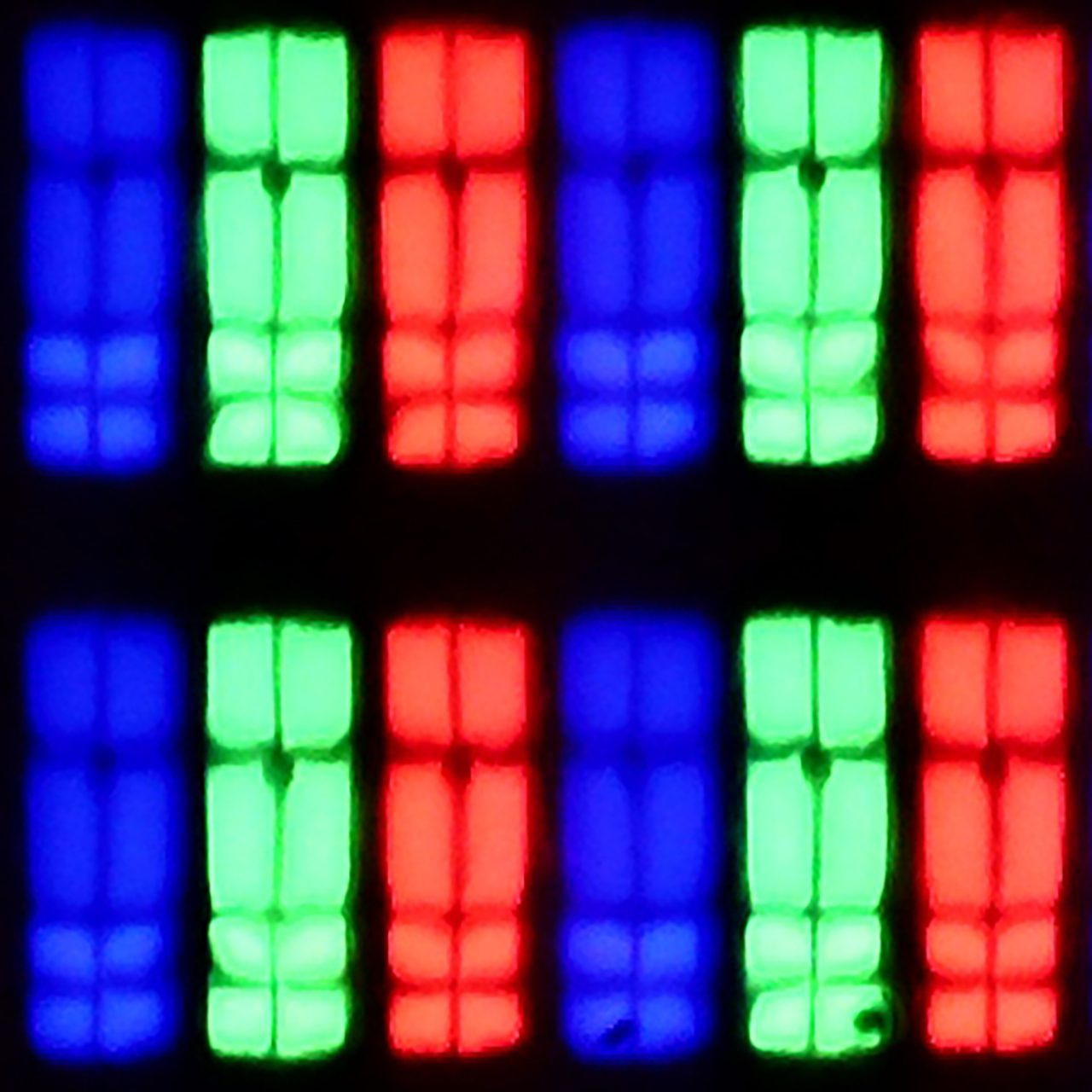
Panel uniformity:

Hisense U7NQ
TCL C7K / QM7K
TV features
9/10
7.7/10
- HDMI inputs2 x HDMI 2.0, 2 x HDMI 2.1 48Gbps2 x HDMI 2.0, 2 x HDMI 2.1 48Gbps
- OutputsToslink (Optical audio), eARC (HDMI), ARC (HDMI), Mini-Jack (Headphones)Toslink (Optical audio), eARC (HDMI), ARC (HDMI)
- Network InterfacesWi-Fi 2.4GHz, Wi-Fi 5GHzWi-Fi 2.4GHz, Wi-Fi 5GHz, Ethernet (LAN) 100Mbps
- TV receptionDVB-T, DVB-T2, DVB-S, DVB-S2, DVB-CDVB-T, DVB-T2, DVB-S, DVB-S2, DVB-C
Classic features:
- Recording to USB (terrestrial TV)
- Recording programming
- Picture in Picture (PiP)
- RF remote control (no need to aim at the screen)
- Backlit remote control
- Teletext
- Audio only mode
- Possibility to connect Bluetooth headphones to the TV
- Possibility to simultaneously use Bluetooth headphones and the TV speaker
Smart features:
- AirPlay
- Screen mirroring (Windows Miracast)
- Wyszukiwanie głosowe
- Voice search in native language
- Ability to connect a keyboard and mouse


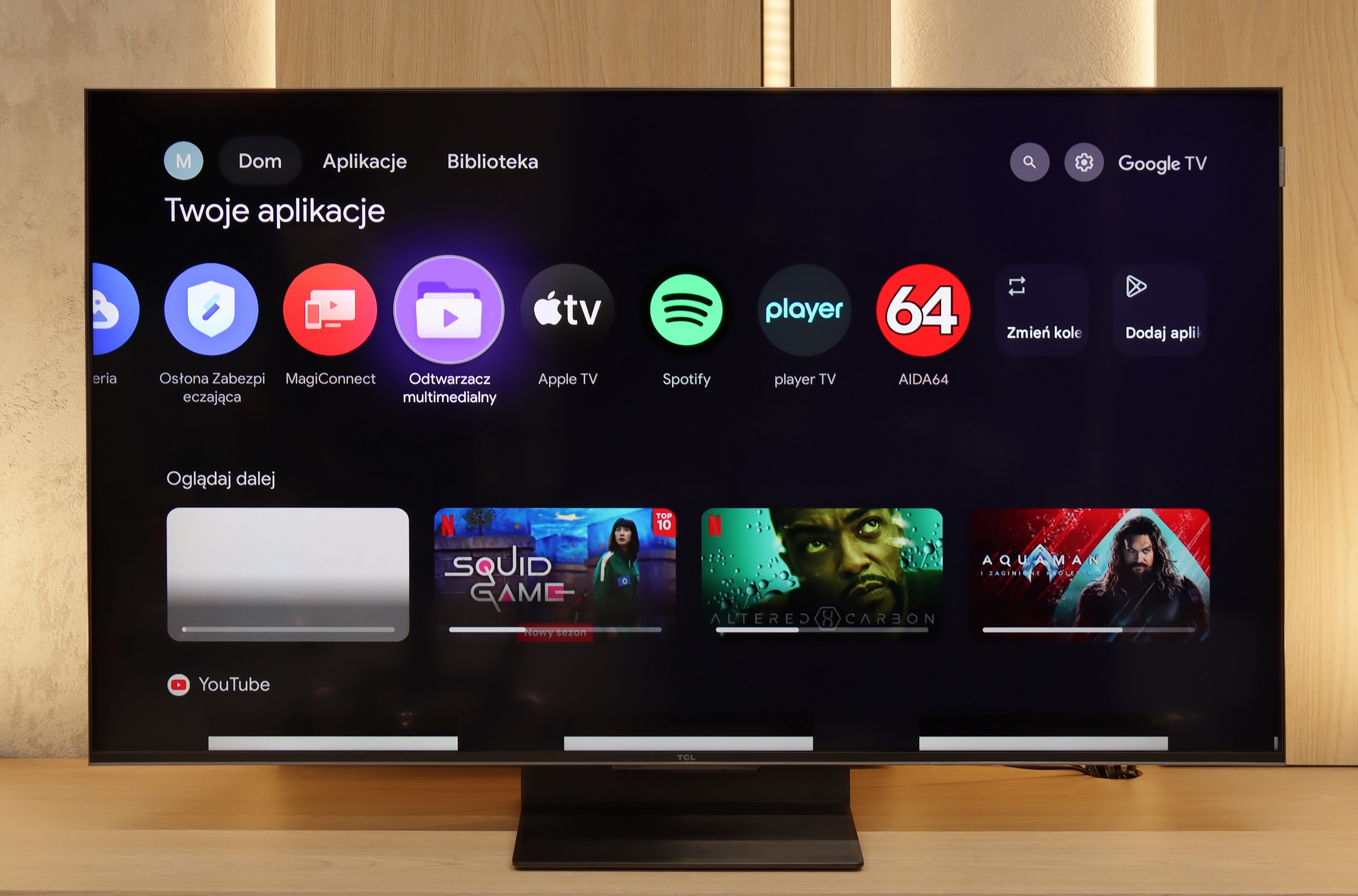
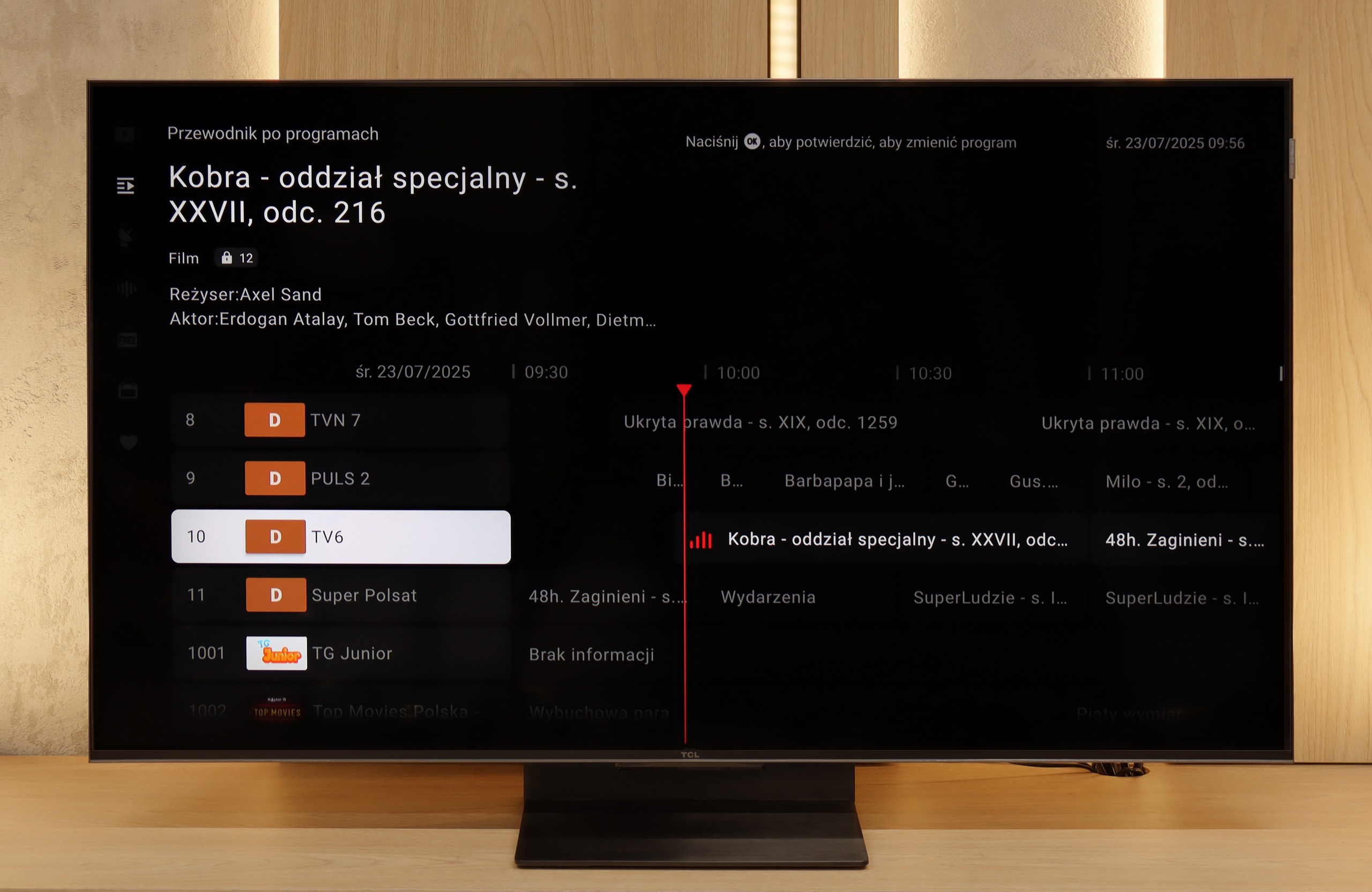
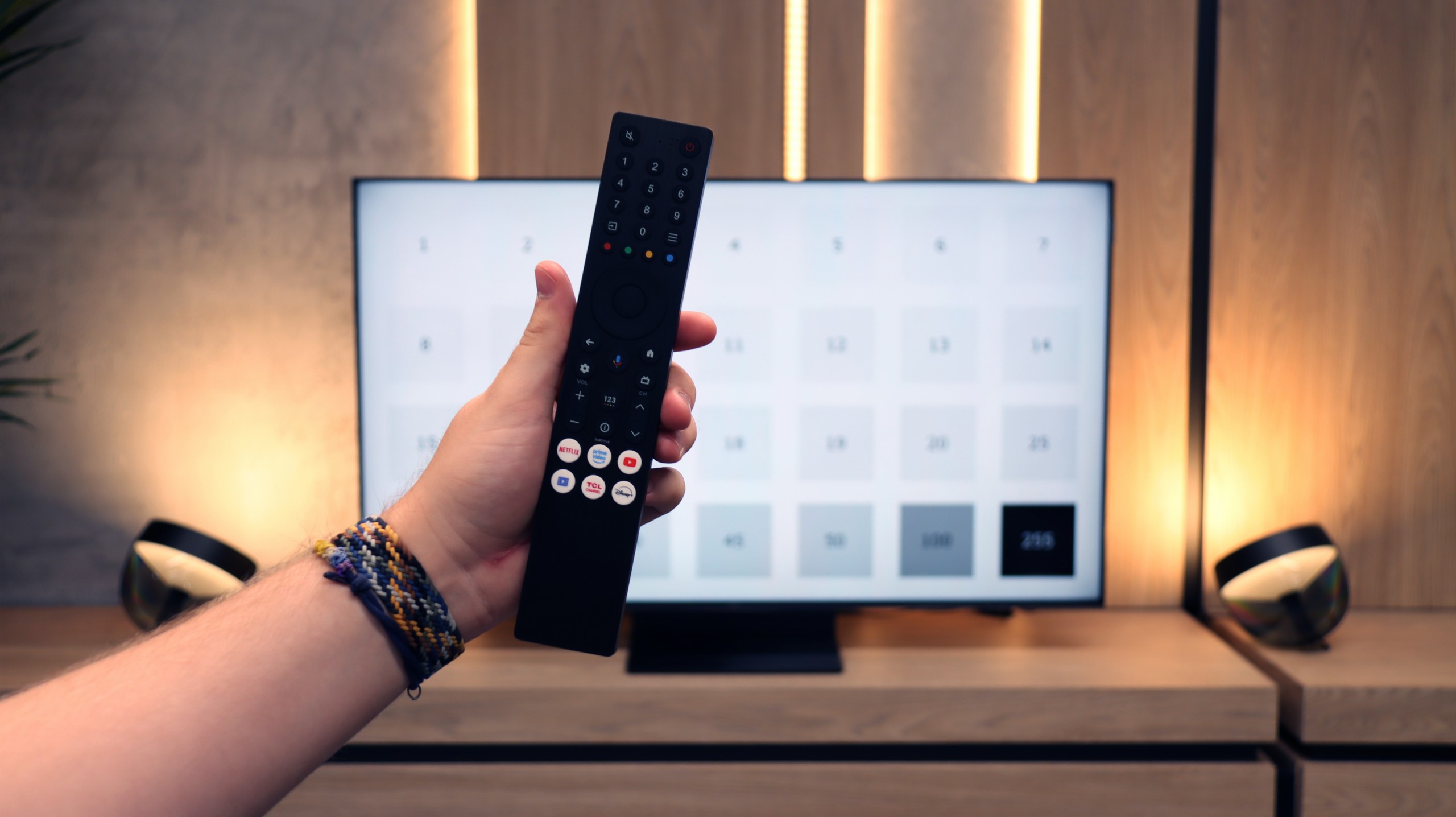
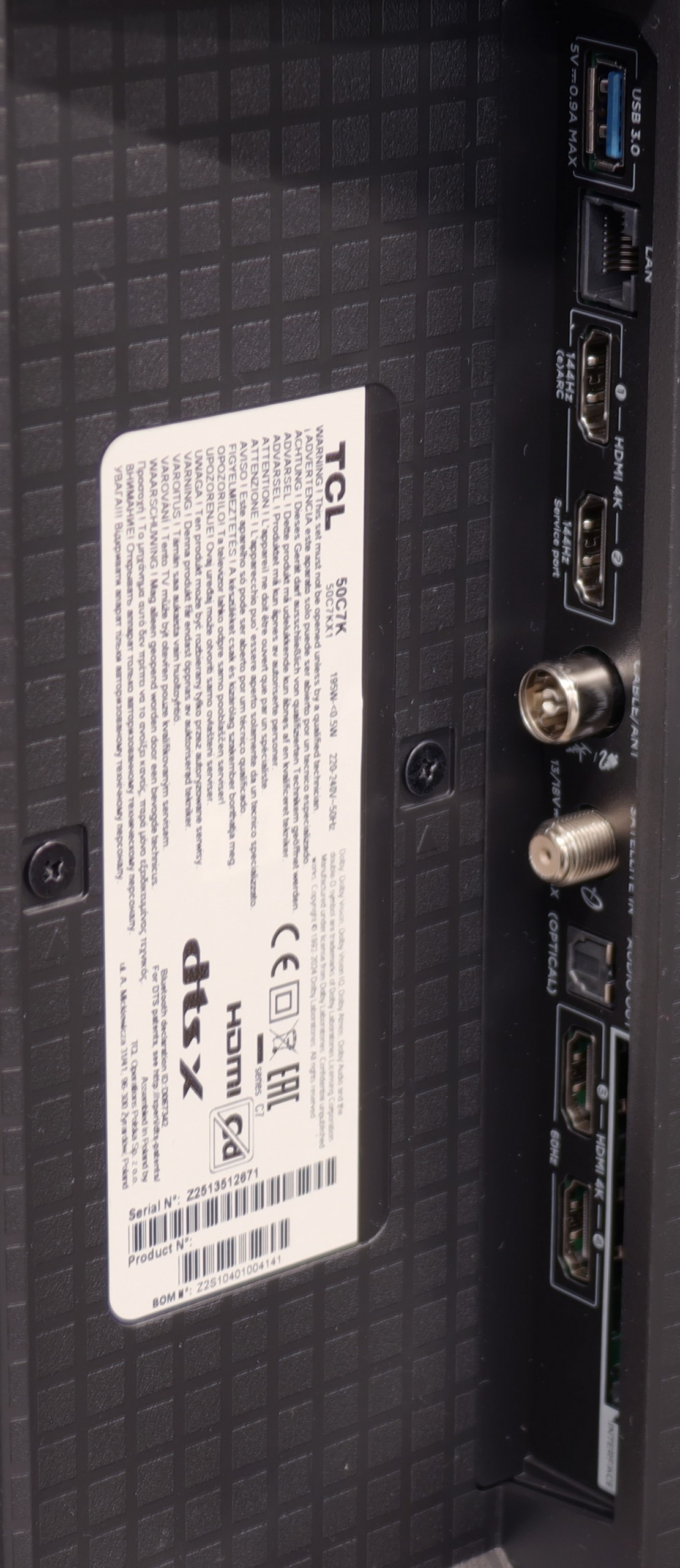
Hisense U7NQ uses the VIDAA operating system, which generally works quickly and smoothly, offering a user-friendly interface. There are plenty of applications available, but unfortunately, it lacks music apps like Spotify or Tidal. This is a limitation that may discourage users looking for a more developed app ecosystem.
The TV offers many useful user features that enhance its versatility. The ability to record programs, support for AirPlay, and Bluetooth for connecting various peripheral devices mean that the Hisense U7NQ can successfully serve as a central point for home entertainment.
Hisense U7NQ looks modern thanks to its narrow bezels and elegant single stand that pairs well with the rest of the device. However, the device itself is not among the sleekest on the market, especially compared to competing models from Korean manufacturers known for their exceptionally thin TVs. Despite this, Hisense U7NQ still offers an aesthetic and stylish design that will easily fit into most interiors.
SmartTV: GoogleTV
The greatest strength of the TCL C7K in everyday use is undoubtedly the Google TV system. Thanks to it, we have access to an almost endless library of apps, including more niche ones that are often unavailable on other platforms. The built-in Google Assistant understands Polish, so we can easily ask what's on TV, what the weather is like, and even give a few voice commands to control the television. It's also worth noting the presence of Chromecast and AirPlay, which work smoothly and make life easier.
Usability Features
On the downside, the classic features are somewhat lacking. Of course, we find the basics here – teletext, EPG, or the ability to connect headphones – but that's pretty much it. There's a lack of USB recording functionality or picture-in-picture (PiP) mode, which can sometimes still be found with the competition. It's also worth remembering that the Google TV implementation on TCL can sometimes have oddly translated menu sections or minor interface bugs. These are not issues that hinder everyday use, but detail-oriented individuals may notice them.
Playing files from USB
9/10
9.2/10
Supported photo formats:
Maximum photo resolution:


The built-in media player in the TCL C7K performs really well. It supports most popular audio and video formats, so if we want to quickly throw something from a USB drive and play it – there shouldn’t be any problem. Of course, as is usually the case, there are some minor shortcomings – not every exotic codec will work (Apple's HEIC), not all subtitles will be perfectly synchronized (txt.). However, this is where the biggest advantage of this TV comes in, which is Google TV. With access to the Google Play store, we can easily install an alternative player, like VLC, and then no file is intimidating to us.
Apps
7.7/10
9.6/10














































Sound
6.9/10
7/10
- Subjective sound quality:6.9/107/10
- Dolby Digital Plus 7.1:
- Dolby True HD 7.1:
- Dolby Atmos in Dolby Digital Plus (JOC):
- Dolby Atmos in Dolby True HD:
- DTS:X in DTS-HD MA:
- DTS-HD Master Audio:
To be honest, we didn't expect much from the sound in the 50-inch version of the C7K model. Usually, in such sizes, it's hard to get anything more than a thin, flat sound. But here – a pleasant surprise. The sound turned out to be really enjoyable, with good clarity and even a slightly perceptible bass. This is probably related to TCL's new collaboration with the Bang & Olufsen brand, which is new for 2025. Whether the C7K actually features original drivers from the Danish premium brand – we can't confirm. But the final effect is still deserving of a plus. For a TV without a soundbar – it sounds quite nice.


